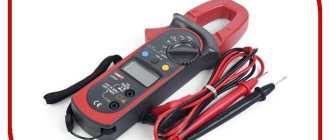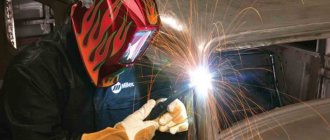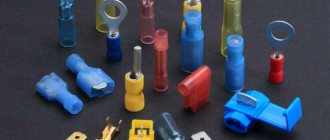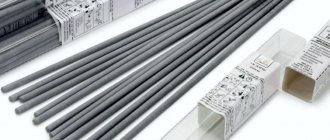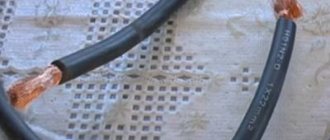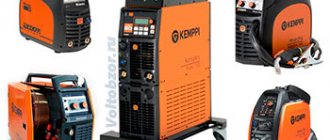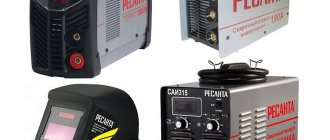The spot method of resistance welding of reinforcement is used in the assembly of frames for reinforced concrete products and the production of meshes from rods. The technology is based on the principle of converting the kinetic energy of current into heat; the metal is joined without the use of additives. Equipment for resistance spot welding is made independently on the basis of existing welding machines. Automatic machines are used to produce reinforcing mesh on an industrial scale. The operating current mode is selected for the reinforcement, taking into account the type of alloy and the thickness of the rod.
Advantages and disadvantages of the method
Like any other method of hot metal joining, the contact-point method has a number of advantages:
- high productivity, especially when using automatic machines;
- low scrap yield, high-quality homogeneous compounds are formed;
- the seam is strong, bears bending and torsion loads;
- no consumables are needed for surfacing; a diffusion layer is formed when the rod melts;
- work is carried out in any spatial position;
- equipment comes in two types: stationary and portable;
- By adjusting the parameters of the operating current, they select the mode for any type of rods:
- no residual stresses are created in the metal.
Along with the advantages, the method has disadvantages:
- the preparatory stage takes a lot of time - there are special requirements for the contact area with the electrodes;
- physical effort is required;
- high energy consumption;
- you need a powerful current source;
- When working with manual equipment, both hands are used, the compression force is limited by the physical capabilities of the welder.
Methods of resistance welding of reinforcement
First, a few words about the essence of the welding process. Current is supplied to the working area through contact non-consumable electrodes, the rod is placed between them. When the electrical circuit is closed, an electric arc occurs, which heats the metal in a matter of seconds. The impact zone is limited by the area of the electrodes.
The resistance welding method is based on the high resistance of the reinforcement and the principle of converting the kinetic energy of electrons into thermal energy. Contact electrodes are made of non-ferrous metals with low resistance, so they do not heat up during operation. When the contacts are compressed, the diffuse layer is compacted; special lever or pneumatic actuators are used to connect thick reinforcement.
The rods can be welded end-to-end - the ends are completely straightened, overlapping - with the formation of several contact points. When installing reinforced concrete frames, metal rods are overlapped at right angles.
When resistance spot welding of reinforcement, the metal is boiled:
- with the formation of a monolithic unit, the alloy is heated to a melt state;
- with the formation of a contact zone, the metal is heated to the plasticity temperature.
The rate of current supply is limited if necessary; it is permissible to connect the rods:
- Continuous melting, this method is relevant for reinforcements made of steels of category A1, rods produced by cold deformation without subsequent hardening. The current is supplied continuously, the arc penetrates the metal in a constant mode.
- Intermittent reflow method is convenient for welding hardened hot-deformed rods from alloys of categories A2–A4. The arc pierces the metal in a pulsed mode.
Welding machines usually support both heating modes.
Equipment used
Portable welding machines are made on the basis of an existing high-power welding machine. Copper cable turns are used as the secondary winding. The contacts are compressed by a pliers-type lever device. The remote arms for welding reinforcement are lengthened to increase the pressure on the working area.
There are two types of welding pliers:
- stationary, when one of the levers is tightly fixed to a horizontal platform or work table;
- suspended, when the lever is attached vertically;
- portable, both levers are free, the mobility of the equipment is limited by the length of the wire.
Modular machines or machines are more complex; a cooling circuit is provided, automatic bar feeding is provided, there are additional functions, and it is possible to install several electrodes at once.
Design and principle of operation
According to the principle of construction, welding pliers are similar to ordinary pliers, only electrodes are added to the clamping plates, and wires are added to the handles. Welding tongs of any type consist of:
- Current source.
- Trigger mechanism.
- Electrodes.
- Two conductors from pieces of large cross-section cable.
- Swivel lever with clamping mechanism.
To power such a device, a powerful source of electric current is required, which operates at a voltage of 380 V. A conventional transformer, sometimes with a reinforced secondary winding, copes with this function.
An equally important component of the tool for working with resistance welding are electrodes. They are made from copper-based alloys alloyed with chromium, cobalt, cadmium or other chemical elements. Such electrodes have the required strength, heat resistance and fairly low electrical conductivity, which ensures good performance of point connections.
To form a tight welding point with welding pliers, after applying electric current, it is necessary to squeeze the handles of the device with force. For ease of squeezing, the handles of the pliers are often long.
Reinforcement spot welding modes
There are two main modes: hard and soft. Each one is worth saying in more detail.
- Spot welding in a soft mode ensures slow heating of the contact zone. The maximum current density does not exceed 100 A/mm2, the current speed is maintained in the range from 1.5 to 3 seconds depending on the diameter of the rod. In soft mode, high-power equipment is used; the electrical network sags less during operation. Reduced risk of residual stresses. When heated, the properties of steel do not change - no hardening effect occurs. The method is used for cold-drawn reinforcing bars.
- The hard mode involves operating at a dense current, from 120 to 300 A per unit area. The speed of exposure is correspondingly lower than in soft mode: from 0.1 to 1.5 seconds. With this method, a hardening effect occurs, so only hot-rolled rods that were heated during the manufacturing process are cooked in a hard mode.
Welding technology
- Preparatory stage. Before resistance welding of reinforcement, it is important to properly prepare the rods. The contact areas are cleaned to a metallic shine, then degreased. The strength of the seam depends on the quality of surface preparation. There should be no traces of paint, oil, or rust on the surface. Even after processing the metal with a cutter, cleaning with a wire brush is required.
- Selecting the operating mode. Depending on the brand of fittings, the current operating parameters are adjusted to prevent welding defects. Determine the time intervals of exposure and the clamping force of the reinforcement. When working with rods thinner than 5 mm, it is important not to pinch the contact area.
- Welding process. The end-to-end reinforcement is placed between the electrode contacts. They compress it in the area of the future seam, only then turn on the power. During the heating process, the electrodes continue to compress to ensure interdiffusion.
- After completion of the work, the quality of the connection is checked. If necessary, the reinforcement is welded again with different current parameters.
When working, it is important to follow safety precautions; you do not need to wear a face shield, but safety glasses are required. The equipment is grounded, hands are insulated with mittens. Check the strength of fastening of stationary installations. Before work, check the quality of the cable insulation. When heated, harmful components are released; ventilation must be provided.
The contact spot welding method of reinforcement is the most economical and simplest. Does not require consumables. The contact zone is created due to the internal heating of the metal by an electric arc. The speed of work is high, but the connection density is limited by the force of squeezing the electrodes.
Source: svarkaprosto.ru
Features of choice
Before you decide to buy a tool for resistance welding, you need to know the criteria for choosing a quality unit:
- Operating voltage and current strength. All devices are designed for a specific voltage - 220 V or 380 V.
- Electrode extension is the distance between the electrodes and the unit body. The larger it is, the further from the edge you can weld parts.
- Electrode clamp type. Terminal or threaded.
- Weight of the welding unit.
- Performance.
In addition, it is worth paying attention to the energy consumption of the structure and possible additional properties that do not always add benefits.
Having decided on the specified parameters, as well as having carefully studied the desired modification of the device, you can safely make a purchase.
It has been established that it is more effective to use hand pliers when working with thin sheet metal, and mechanized ones when working with thick sheets.
Equipment for welding reinforcement and mesh
Contact and butt welding of reinforcement is the most common method of assembling reinforcing mesh and reinforcing cages at enterprises producing reinforced concrete products (RCP) and at house-building factories (DSK). Manual arc welding is often used for welding reinforcement, but recently this method has been successfully replaced by welding using resistance and butt welding machines.
Contact and butt welding has a number of advantages:
- high performance;
- lower labor costs;
- lack of consumables;
- lower cost.
There are a number of documents regulating the production of products from reinforcement using contact and butt welding GOST, OST, etc.
Resistance welding of reinforcement is used for cross-shaped joints and lap joints. For these connections, suspended pliers for welding reinforcement and stationary machines manufactured by TECNA (Italy) are used. TECNA equipment is known at enterprises that weld reinforcement cages and reinforcing mesh, and has proven itself to be very reliable, high-quality equipment.
Butt welding of reinforcement is accordingly used for butt welding of reinforcement. For such welding, our company offers equipment from IMS (Italy). IMS A company that produces a wide range of high-quality equipment for resistance butt welding. The machines are equipped with reliable pneumatic clamps and hydraulic drives. The machines are designed to operate in high-load industrial environments. The design of the machines meets the highest requirements for performance and reliability. The equipment is widely used in the construction industry.
For welding mesh from reinforcement, our company offers multi-point automatic machines and lines for welding reinforcement mesh from IMS. The company has extensive experience in the design and production of machines for welding mesh. High performance properties, productivity, quality, ease of operation and ease of management are some of the main parameters of machines and lines from IMS.
Welding reinforcement using resistance welding pliers TECNA 3323
Welding reinforcement using resistance welding pliers TECNA 3322
Relief welding of mesh on a stationary machine 6102 - 100 kVA - 736 daN - 50 kA
Modular machines 4040 for multi-spot welding
Source: rutector.ru
Design and types of pliers
Manual welding guns for resistance welding include:
- The housing in which the equipment in question is connected to the welding transformer.
- Swivel arm with clamp for top electrode.
- Bottom electrode clamping unit.
- The handle on which the controls are mounted. For more powerful standard sizes of pliers, pedal activation is provided. The second, side handle is designed to hold the tool during welding.
- Monitoring and control system based on various types of relays - welding current interrupters.
- An extension cord or apron if you need to carry out welding work at some distance from the transformer.
Although the electrodes are not included in the kit, all technical characteristics of the welding pliers produced are based on a specific type and diameter of the consumable. The presence of such a tool significantly reduces the labor intensity of welding, since when working in different places, there is no need to move a massive welding transformer. This is why resistance welding pliers are especially popular in auto repair shops that perform body repair work.
Welding pliers are classified according to the following criteria:
- By installation method. Hanging pliers are popular for industrial resistance electric welding in large volumes, while manual, more compact ones are better for welding in hard-to-reach places.
- By electrode clamping drive, which can be manual or pneumatic.
- According to the drive principle. Automatic pliers are triggered by a control signal from a relay, which turns on when a certain compression force of the electrodes is reached. Mechanized versions are activated by a pedal or by pressing a button on the handle.
- According to the method of cooling the electrode holder. When using high welding currents for contact welding, it is more efficient to use water; in other cases, cooling is carried out using an air jet.
- In terms of performance. Welding tongs with water cooling are capable of ensuring the welder’s work rate at the level of 500...700 points per hour, and tongs with air cooling - no more than 60...70.
A type of welding pliers are spotters - devices that provide manual clamping of electrodes. They are used for resistance welding of small parts.
Hanging pliers for resistance spot welding TECNA (Italy)
Suspended resistance spot welding guns have high productivity due to the use of high-tech transformers and built-in control units in their design, as well as the presence of water cooling. The weight of the pliers is compensated by balancer hoists, so this type of equipment is mobile, ergonomic and safe to use. All this makes it possible to use pliers when welding products of a wide variety of dimensions and shapes, for example, railway cars, car parts, building metal structures, and welding of reinforcement.
Distinctive features
The insulated body of the pliers facilitates comfortable and safe operation for the operator;
The suspended gyroscopic bracket and the mechanism for blocking rotation of the pliers provide the ability to operate the pliers in various positions;
Water cooling is used to maintain the operating temperature of the main parts of the clamps: electrode holders, arms, transformer and working electrodes;
The pliers are equipped with an automatic safety switch, as well as a safety device on the plier handle to prevent inadvertent activation;
Various modifications of the built-in control units make it possible to adjust the following parameters: compression force, speed of reduction and extension of the shoulders, stroke length of the electrodes
The pneumatic cylinder of the pliers does not require lubrication and is designed to work, including in difficult conditions of high dustiness, high flow capacity
Possibility of fast maintenance.
Source: rutector.ru
Manufacturers of welding guns
Many companies specializing in welding equipment are engaged in the design and production of spot welding pliers. Their arsenal includes both universal manual or suspended models, which can be configured within a fairly wide range, and highly specialized ones, for example, for welding car wheel rims or frame parts. The latter are usually installed as part of conveyor lines.
The most famous manufacturers of pliers are PEI-POINT (Italy), ITS (Russia), FOXWELD (Italy), Dalex Schweißmaschinen, ELMATech GmbH (Germany) and several other international companies.
For household use, you can buy relatively inexpensive Chinese tools that are not very suitable for industrial use, but are quite appropriate in a garage or home workshop. They provide infrequent welding of steel, aluminum, copper and other non-ferrous metals at a fairly high quality level.
Advantages of connecting reinforcement using spot welding
One of the areas of spot welding, production of structures from reinforcement
It should be noted that resistance spot welding is used for welding reinforcement. The use of this particular type of welding makes it possible to automate and mechanize the entire process of manufacturing reinforcement as much as possible, as well as to achieve a reduction in the labor intensity of the work. However, this is far from the only area of application for spot welding. Thus, this variety is widely used for some other industrial purposes, for example, they often resort to resistance spot welding for batteries. The use of resistance spot welding is also possible at home for repairing household appliances, performing cable work, etc.
Spot welding machine: description
The devices used for resistance spot welding are different, and their design is also varied. For example, for relatively small volumes of work, single- and two-electrode machines are widely used. If it is necessary to weld heavy reinforcement, as well as for the purpose of welding individual rods, other devices are used: overhead contact machines with welding jaws.
All manufactured machines have either one-way or two-way power supply. In the second case, the current is supplied to the lower and upper rods.
When the current supply is one-sided, it is done from the secondary turn of the transformer (from below). Devices with one-sided supply are characterized by a shorter flow length, which has a significant effect on the resistance (in the direction of its reduction). As a result, there is an increase in productivity due to the ability to simultaneously weld several intersections.
All welding machines for single- and multi-point resistance welding are divided into stationary and suspended. At the same time, pendant ones also come with a built-in transformer or an external one.
Single-point stationary devices equipped with a hydraulic drive, and some suspended ones with a pneumatic drive (type MTP-75 and MTPP-75, respectively), are characterized by relatively low productivity and a small reach of the trunk of the electric holder. Such devices are used to perform small-volume work.
Single-point hanging machines, with power ratings up to 75 kW, allow the connection of reinforcement where the smaller rod will have a minimum diameter of up to 16 mm. Similar stationary devices allow welding rods with a diameter of up to 22 mm.
If it is necessary to weld fittings of a larger diameter, other devices with significantly greater power are used. They also resort to multi-point resistance welding.
Homemade spot welding pliers
But, with some skill and effort, making spot welding pliers with your own hands is not too difficult.
True, in most cases, they belong to a combined type, in which the transformer part and the mechanical part are somewhat separated in space, as, for example, shown in the video: This design is due to the fact that it is quite difficult to make a compact transformer and combine it with clamps in this way , so that the device turns out to be balanced and, at the same time, powerful enough. And balance is very important to achieve high precision welding.
In most cases, home craftsmen build stationary pliers, which are installed on a bed and the part being welded is moved. But in this case, their main property is lost - mobility and the ability to weld in any position.
Successful mechanical solutions for homemade pliers are shown in the photo:
Mechanical homemade pliers
Mechanical homemade pliers
The flight of imagination of amateur designers is unlimited, so on the Internet you can find many very original designs that work no worse, or even better, not at all offensive - it shows that design thought is not limited by the narrow framework of the technical specifications of the enterprise and can work freely.
If spot welding of your own design works in your garage or workshop, share a diagram, photo, video or description with our readers. This will no doubt arouse considerable interest.
Welding technology
Since spot welding of reinforcement is a type of contact welding, the process is based on the well-known Joule-Lenz law, according to which the thermal effect of electric current occurs, as well as the principle of compression force of the parts being welded.
Almost jewelry work, with copper electrodes
The technology looks like this in more detail. During single- or multi-point resistance welding of reinforcement, current from one electrode passes to another directly through the metal. By the way, the electrodes themselves used in resistance spot welding are made from alloys with high electrical conductivity. This allows us to ensure the least resistance in the “electrode-component” connection. As a result, in the “part-to-part” connection there is the greatest heating, since this is where the maximum resistance occurs.
Spot welding of reinforcement
It is carried out in one of two modes: soft and hard. The first technology is different in that:
- More time is required for welding;
- The workpieces heat up smoothly;
- The current density directly on the working surface of the electrode does not, as a rule, exceed 100 A/mm 2 ;
- The current itself flows in 0.5-3 s.
The advantages that characterize this technology are:
- Less power consumption;
- Less network load;
- The need for devices of lower power and, accordingly, lower cost;
- Finally, it is necessary to note such an advantage as reducing the hardening of the welding zone.
The second mode – hard – is characterized by other features:
- The welding time is shorter here;
- Current indicators are higher, they reach 120-300 A/mm 2;
- The current in hard mode flows in 0.1-1.5 s.
The main advantage of this technology for welding reinforcement is the overall reduction in time spent on joining and a significant increase in productivity.
However, there are also some disadvantages, in particular: increased power that is consumed during operation, serious network loads.
How to work with welding tongs?
The presence of welding pliers eliminates the main problem of resistance welding - the need to supply large current values to the working area while simultaneously ensuring the mobility of the welder. Welding wire is not suitable in such situations, so only electrodes should be used. Special requirements are placed on the housing: it must ensure safe power transmission, reliable fixation of both clamping units and ease of use. Therefore, welding tongs for industrial use are usually equipped with a fastening unit, with which they are attached to the more rigid part to be welded.
Preparation for welding using welding pliers begins with the installation of electrodes in the clamping units. A terminal clamp, which is more reliable, is used more often. The most important characteristic of the equipment is the reach - the distance from the axis of rotation of the movable clamp to the axis of the electrode. The amount of overhang determines the maximum distance from the edge of the welded product. In most equipment designs, the overhang is a variable value and varies within the range of 125...500 mm. This increases the functionality of the device.
The reach can be adjusted smoothly and in steps. In cheaper designs, the amount of overhang is changed by reinstalling the electrode holders into the required grooves or holes on the body. In automatic welding guns, the reach is sometimes adjusted using a plunger that is pulled out using compressed air. However, such devices have not gained popularity among welders: the pliers are becoming heavier, and for stable air supply a receiver is required, which makes the equipment more cumbersome.
Having decided on the amount of overhang, the pliers are installed in the required location and the current supply is turned on. The relay will supply current to the electrodes while providing the required compression force. Having placed the next welding point, turn off the power using a pedal or handle, after which the tool is moved to a new position.

